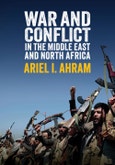For much of the last half century, the Middle East and North Africa (MENA) has seemed the outlier in global peace. Today Iraq, Libya, Israel/Palestine, Yemen, and Syria are not just countries, but synonyms for prolonged and brutal wars. But why is MENA so exceptionally violent? More importantly, can it change?
Exploring the causes and consequences of wars and conflicts in this troubled region, Ariel Ahram helps readers answer these questions. In Part I, Ahram shows how MENA’s conflicts evolved with the formation of its states. Violence varied from civil wars and insurgencies to traditional interstate conflicts and affected some countries more frequently than others. The strategies rulers employed to stay in power constrained how they recruited, trained, and equipped their armies. Part II explores dynamics that trap the region in conflict - oil dependence, geopolitical interference, and embedded identity cleavages. The catastrophic wars of the 2010s reflect the confounding effects of these traps, culminating in state collapse and intervention from the US and Russia, as well as regional powers like Iran, Saudi Arabia, and the UAE. Finally, Ahram considers the possibilities of peace, highlighting the disjuncture between local peacebuilding and national and internationally-backed mediation.
War and Conflict in the Middle East and North Africa will be an essential resource for students of peace and security studies and MENA politics, and anyone wanting to move beyond headlines and soundbites to understand the historical and social roots of MENA’s conflicts.
Exploring the causes and consequences of wars and conflicts in this troubled region, Ariel Ahram helps readers answer these questions. In Part I, Ahram shows how MENA’s conflicts evolved with the formation of its states. Violence varied from civil wars and insurgencies to traditional interstate conflicts and affected some countries more frequently than others. The strategies rulers employed to stay in power constrained how they recruited, trained, and equipped their armies. Part II explores dynamics that trap the region in conflict - oil dependence, geopolitical interference, and embedded identity cleavages. The catastrophic wars of the 2010s reflect the confounding effects of these traps, culminating in state collapse and intervention from the US and Russia, as well as regional powers like Iran, Saudi Arabia, and the UAE. Finally, Ahram considers the possibilities of peace, highlighting the disjuncture between local peacebuilding and national and internationally-backed mediation.
War and Conflict in the Middle East and North Africa will be an essential resource for students of peace and security studies and MENA politics, and anyone wanting to move beyond headlines and soundbites to understand the historical and social roots of MENA’s conflicts.
Table of Contents
IntroductionPart I
Chapter 1: Accounting for War in the Middle East and North Africa
Chapter 2: The MENA Security Predicaments
Part II
Chapter 3: Oil as Conflict Trap
Chapter 4: Identity as Conflict Trap
Chapter 5: Geopolitics as Conflict Trap
Chapter 6: Fragmentation, Integration, and War in the 2010s
Chapter 7: Peace and Peacemaking








